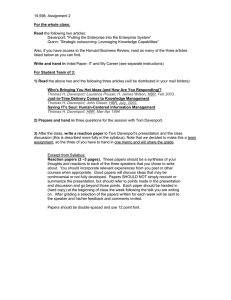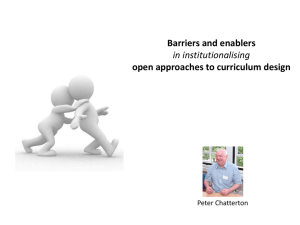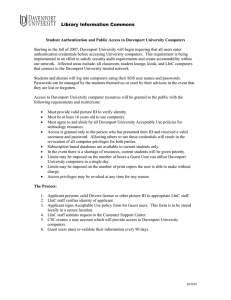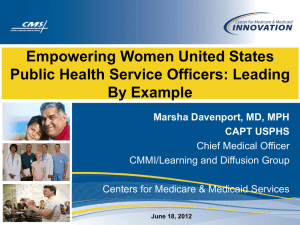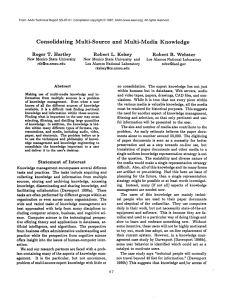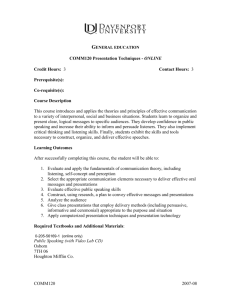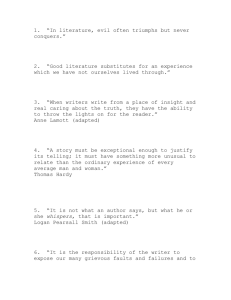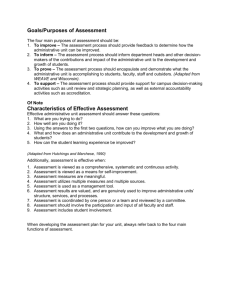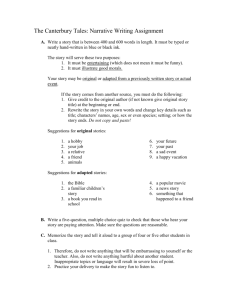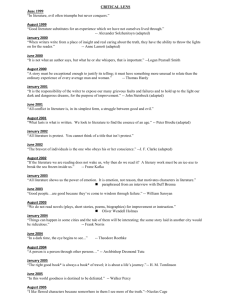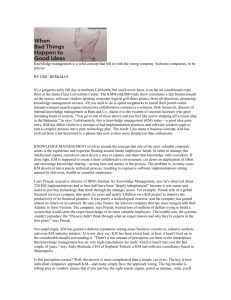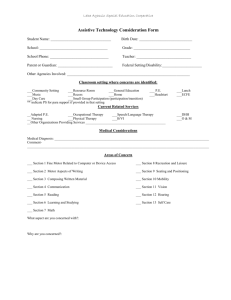What is a Process?
advertisement
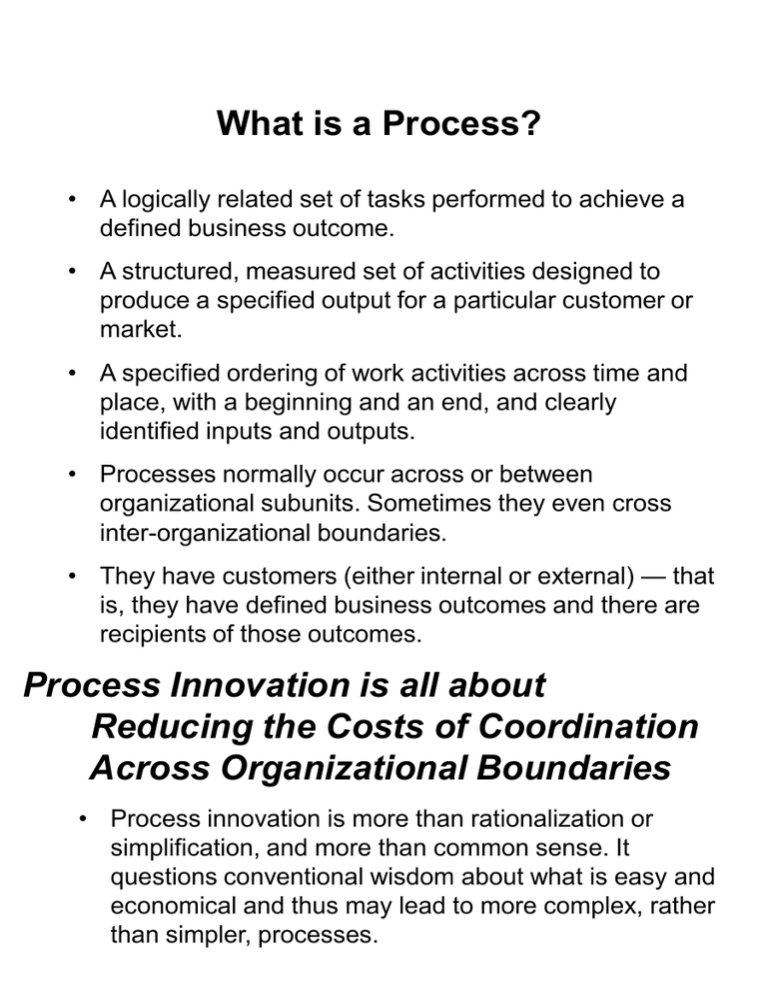
What is a Process? • A logically related set of tasks performed to achieve a defined business outcome. • A structured, measured set of activities designed to produce a specified output for a particular customer or market. • A specified ordering of work activities across time and place, with a beginning and an end, and clearly identified inputs and outputs. • Processes normally occur across or between organizational subunits. Sometimes they even cross inter-organizational boundaries. • They have customers (either internal or external) — that is, they have defined business outcomes and there are recipients of those outcomes. Process Innovation is all about Reducing the Costs of Coordination Across Organizational Boundaries • Process innovation is more than rationalization or simplification, and more than common sense. It questions conventional wisdom about what is easy and economical and thus may lead to more complex, rather than simpler, processes. Processes Improvement versus Innovation Improvement Innovation Incremental Radical Existing process Clean slate One-time or continuous One-time Short Medium (very focused) Participation Bottom-up Top-down Typical Scope Narrow, within functions Broad, cross-functional Moderate High Primary Enabler Statistical control Information technology Type of Change Cultural Cultural & structural Level of Change Starting Point Frequency of Change Time Required Risk Ultimately, a major challenge in process innovation is making a successful transition to a continuous improvement environment. An organization that does not institute continuous improvement after implementing process innovation is likely to revert to old ways of doing business. Source: Adapted from Davenport (1993: 23-25) High-Level Approach to Process Innovation Identify Processes for Innovation Exhaustive vs. High-impact Approaches Identify Potential Change Levers Especially IT Develop Process Vision Understand Existing Processes Measurement and benchmarking Design & Prototype New Process Source: Adapted from Davenport (1993: 23-25) Selecting Processes for Innovation Key Activities Enumerate Major Processes Determine Process Boundaries Assess Strategic Relevance of Each Process Render High Level Judgments of the “Health of Each Process Qualify the Culture and Politics of Each Process Source: Adapted from Davenport (1993: 27) During Enumeration Provide Both Written Description (Definition) and Context Specification for Each Process • The Order-to-Remittance Process encompasses all organizational activities which take place from the time a customer order is received through the receipt of payment. This includes the management of the order and inventory, manufacturing, distribution planning, shipping, traffic management, delivery, invoicing, and payment processing. Loosely Identify: Process Context, Inputs, and Outputs Orders, Customers Requests, Requirements, Payments Products OTR Boundary Definition Questions to Keep in Mind • When should the process owner’s concern with the process begin and end? • When should the process customers’ involvement begin and end? • Where do subprocesses begin and end? • Is the process fully embedded in another process? • Are performance benefits likely to result from combining the process with other processes or subprocesses? Strategic Relevance and Health Criticality to Organization Mission and Strategy Degree to Which Current Implementation Meets the Challenge (“Health”) High Medium Low High Medium Low Health Indicators • Ratio of value-added time to cycle time. • Does current process cross many functions (or organizations)? • Does current process involve many narrowly defined jobs? • Does current process have clearly defined owner and customers? (Does anyone get upset when the process product is late or over budget? Do we know who is responsible? Who ya gonna’ call?) Identifying Change Enablers Key Activities Identify potential technological and human opportunities for process change Identify potential technological, human, and fiscal constraints on process change Research opportunities in terms of application to specific processes Determine which constraints will be accepted Source: Adapted from Davenport (1993: 248) IT Enablers: Capabilities and Benefits Capability Benefit Transactional Transform unstructured processes into routinized transctions. Geographical Transfer information with rapidity and ease across distances; make processes independent of geography Automational Replace or reduce human labor in a process. Analytical Bring complex analytical methods to bear; improve analysis of information and decision making Informational Bring vast amounts of detailed information into the process; capture process information for later analysis Sequential Enable changes in the sequence tasks must be performed; allow multiple tasks to be worked on simultaneously Knowledge Management (Intellectual) Capture and disseminate expertise to improve the process Tracking Monitor task status, inputs, and outputs Disintermediating Connect two parties within a process that would otherwise communicate through an intermediary Source: Adapted from Davenport (1990: 17) Organizational Enablers Structure, Culture, and Human Resources • Too many systems fail to yield any real benefit because of human problems in implementation. Such issues must be addressed in the early stages, not as an afterthought. • Work teams (simultaneously bringing cross-functional skills to bear) are the most common structural enablers of process reengineering. In many cases, IT also must be used to allow the team to work together effectively. • In many cases, the organizational cultural will have to shift in order to empower the teams. But this need not always be the solution. IT can support either culture — empowerment or control. • Human relations policies — how individual workers are trained, motivated, compensated, evaluated — must be aligned with the human requirements of the process. • In some cases, current employees do not possess necessary skills and can not easily be retrained. This constraint may preclude process innovation. Create a Process Vision: Aligning the Organization’s Strategy and Processes • Process innovation is meaningful only if it improves an organization in ways that are consistent with its strategy. Embody the organization’s strategy in a vision of the future process state. (Hint: it is this “moral” vision that provides justification for the innovation effort. The justification is not “saving money,” but “making it easier to do business with the State” or “helping local government.”) • Process visions, like strategies, should be easy to communicate to the organization, nonthreatening to those who will be affected, and as inspirational as measurable targets can be. • Congruence or alignment between strategies and processes is essential to radical change in business processes. Without a linkage to strategy and vision, process change seldom goes beyond simple streamlining — good, but not innovation. (Even process streamlining is most valuable when done in areas crucial to organizational success.) • But remember, nonfinancial strategies make sense only to the extent that they lead to better (often, but not always, financial) performance. Developing the Process Vision Key Activities Assess existing business strategy for process direction Benchmark for process performance targets and examples of innovation Formulate process performance objectives Develop specific process attributes Source: Adapted from Davenport (1993: 248)
